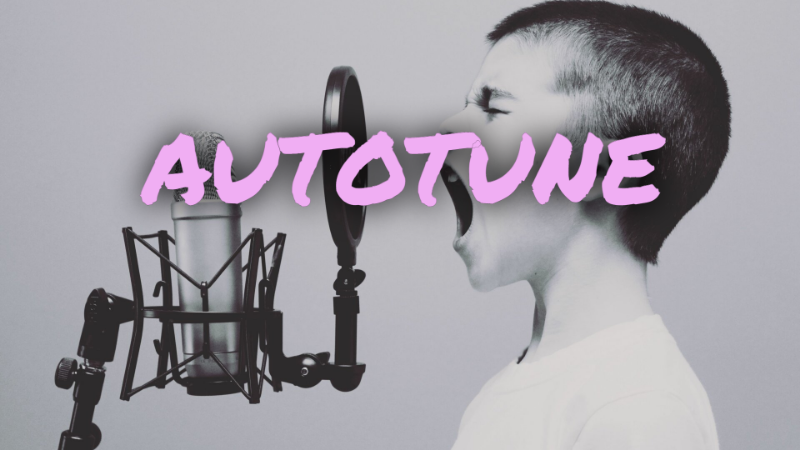
So, you’ve just finished debuting your new recording to some of your close friends and family. Unfortunately they “didn’t get it” and you didn’t get the gushing response you were hoping for. According to them, the vocals repeatedly slipped above and beneath key. With all of the effort that went into putting together the recording, you’re left with the wind knocked out of your sails. But don’t you dare let that get you down. The battle isn’t lost yet. A lot of singers use auto-tune?
Why do singers use Auto-tune and what is it? Auto-tune is vocal pitch correction software used by recording engineers to correct the imperfections of pitch in the recorded performance of a singer. Live engineers may also use Auto-tune to ensure a singer holds key during a live performance. Auto-tune works by designating what key or scale the song is intended to be in. Any divergences from that scale are corrected. The speed of the correction is definable by the user.
Now that we’ve removed some of the pressure in thinking that there wasn’t any hope. Lets work on collecting a better idea of what to know and what to expect.
Applying Auto-tune Correctly
When intended for pitch correction Auto-tune, applied correctly should be undetectable to the listener.
Auto-tune Saves Time and Money
Whether you are a singer or engineer saving time and being most effective in the least amount of time are of equal interest.
When a singer goes in to the recording booth to give their performance they are always under some pressure of a limiting budget. When the Engineer or producer steps into the room to meet the singer they are also under the same pressure of that limiting budget
The Engineer is responsible to do their best to coerce a suitable recorded performance from the singer or artist as timely as possible.
If they can do this efficiently and effectively the singer will be more likely to book time again or give glowing recommendations to other artists that they come into contact with.
After getting warmed up the singer will go into the recording booth and belt out the most expressive and inspired performance that they possibly can.
Regardless of a singers level of ability, the longer you record vocals the more counterproductive the process will become.
The voice fatigues quickly and it doesn’t take long before all of the good energy and enthusiasm succumb to disappoint and self-doubt. So it’s important to manage the singer’s effort well.
And rather then having long intermissions between takes; doesn’t wisdom dictate that we use the tools at our disposal to clean up an otherwise inspired vocal performance and get the show on the road.
More Efficient Then Punching In
When it comes to getting the right vocal take the Engineer or Producer may be laser focused on having a pure Auto-tune free recording. That’s fine when applicable but sometimes the need for practicality outweighs anything else.
We certainly would start by attempting to comp a quality vocal track. If that all works out, great. But the reality of working with vocal comps is that quite often the takes will not match in terms of tone, expressiveness or even proximity.
So when you’re playing-back the comp, and confronted with a collage of chaos. It may be the better strategy to stick with a primary take and do your best to tune one or two words from that take into compliance rather than cutting together a Frankenstein.
Making Non-Singers Singers
What Auto-tune allows you to do is adjust the pitch. Singing entails a lot of factors one of which is pitch. While pitch is a very important part of a performance it is certainly not the only one.
A singer needs to be able to control airflow. They need to know how to breathe. They need to be aware of annunciation and how it can affect their range. They also need to be considerate of their proximity to the diaphragm of the microphone at all times.
A singer must also be able to give their performance in an expressive emotive way. Some one who is experienced should be able to navigate all of those variables.
Auto-tune will not be able to help with any of those factors.
But If you have a singer that can not carry pitch and your only interest is getting them on pitch then Auto-tune would allow you the ability to make enough adjustments to their track that they would indeed sound as if they had sang in key.
It will also allow for some timing manipulation. So if they are slow to the beat or dragging on a bit to long after it, you can easily slide them into sync. With the editing features found in the DAW timing adjustment manipulation is a bit of a redundancy but I thought I’d let you know you can.
Auto-tune for Live Performance
In the recent digital age, the listener is inundated with options so it behooves the artist to prepare and demonstrate their recordings in a flawless way.
These days what makes a recording a recording is that all of the imperfections have been mitigated. The modern listeners have adapted to hearing music this way and any deviances are immediately detected.
It just does not seem that there is any patience for pitch imperfections, between flawless recordings and an oversaturation of television singing contests it’s as if we’ve trained the entire generation to be judges.
So after recording a pristine album the singer goes out to promote the record. To the dismay and outrage of their fans the singer can not hold the key in live performance in the way that it was held on the recording.
So if you’ve climbed up the music career ladder enough or if you have deep enough pockets you may want to consider adding a laptop running Auto-tune or a rack mountable Auto-tune signal processor that runs into the live show signal flow.
Auto-tune for Stylistic Effect
I won’t delve into this too much because it is really beyond the scope of this post, but if you’re one of those people who have been living under a rock for the last few decades a review of recent popular music will introduce you to a warbling effect on the vocals.
It was first introduced by Cher in her song Believe and has been excessively used for effect in pop and hip-hop ever since. This effect is achieved by over adjusting the rate or speed of the correction and by overreaching the amount of correction Auto-tune makes.
Tuned and Ready To Go
So wherever you are in the process, keep in mind you’ll have to do what’s best for you.
If you’re an engineer professional sounding recordings will be your calling card. If they sound unprofessional you won’t get work from them.
If professional sounding means that the singer always sounds in pitch then do what you must. The bottom line is who cares how.
If you’re the singer remember life is short and we all angle and pull to reach the next step. If you are a quality writer and you have a solid song and people who want to hear it. Then get it recorded as well as can be.
I for one listen to a lot of artists who write very clever music all while they may not be the best singer.
Truthfully, I don’t know how well they can keep key because I don’t know if Auto-tune was used or not. Nor should I.
The point is some people listen to music because they want to admire an impeccably talented singer deliver a flawless performance. While others including myself want to hear a clever song, regardless of whatever style of vocal performance that particular song calls for.
So always do what’s best for your music.
Now go and get to it!
Good luck
